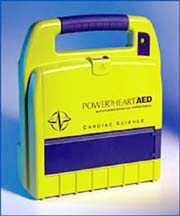According to medical experts, the first four minutes during the onset of a heart attack are considered the most critical in the survival of the victim.
In the past, anyone who was suffering a heart attack (or a myocardial infarction, as a heart attack is known scientifically) had to wait until Advanced Life Support paramedics arrived before they could receive a shock from a defibrillator, which would send the heart back into its proper rhythm.
In recent years, many companies have begun marketing easy-to-use automatic external defibrillators (AEDs) for use by first-responder Emergency Medical Technicians (EMTs) and even by the public at large.
To that end, the Union City commissioners last week voted to accept bids to buy five new updated defibrillators for use by Union City’s volunteer ambulance corps and by the Union City Police Department.
Currently, Union City has six AEDs in use, but at the behest of various Union City EMS officials, it was decided that, in the interest of public safety, the current units were to be updated.
According to George Fierro, Union City EMS supervisor, “We have requested new defibrillators. The majority will be going directly into our ambulances, but a couple will be placed in placed in patrol cars. That way, if our ambulances are tied up, the first responding officer can administer the AED to the victim, if necessary.”
These devices, according to Fierro, are crucial “until we can get the victim to a health care facility, if the person’s heart has stopped, the police officer or EMT can administer a shock to have the heart resume a normal rhythm.”
Heart attack
According to Webster’s Dictionary, a heart attack is “damage to an area of the heart muscle that is deprived of oxygen, usually due to blockage of a diseased coronary artery, typically accompanied by chest pain radiating down one or both arms, the severity of the attack varying with the extent and location of the damage.”
Basically, the heart’s rhythm is regulated by electrical “nodes” located in the heart and when blood flow is blocked, those nodes get confused and send the heart into stuttering, life-threatening rhythms; ventricular tachycardia and/or ventricular fibrillation.
What the defibrillator does is “restart” the electrical nodes on the heart, forcing them to reset themselves into a normal, life-sustaining rhythm, thereby alleviating the devastating consequences of a heart attack.
Other towns’ experiences
According to Hoboken Volunteer Ambulance Corps Supervisor Tom Molta, “We currently have four in service, one in each ambulance and one in our first responder vehicle. I’d say we use the AEDs about twice a month. Since they were put into service in 1997, we’ve seen a marked increase in out-of-hospital cardiac survival rates. They were long overdue.”
Molta went on to explain in a telephone interview that “the actual requirement for use of the AED is to have an unconscious, pulseless, breathless individual, which in reality, means they’re dead. The machine recognizes both ventricular tachycardia and ventricular fibrillation. There is a voice that comes out of the machine and tells you exactly what to do. It’s really foolproof. By having the defibrillators on the Basic Life Support units and in the police cars, it gets help to the people that much faster. The first four minutes is the difference between life and death.”
The machines
The company that Union City has been dealing with for years and that will be one of the companies to enter bids is Cardiac Science, an Irvine, California-based company. According to their web site (www.survivalink.com) the company “is dedicated to providing safe, vigilant and intelligent cardiac monitoring and defibrillation technology that significantly reduces time to defibrillation and saves lives. Cardiac Science’s objective is to raise the standard of care for cardiac arrest victims worldwide, by offering devices to treat in-hospital patients, as well as defibrillation products for public access, corporations, educational institutions, hotel and leisure industry, law enforcement and Fire/EMS applications.”
According to Cardiac Science Territory Manager Rocco Palmisano, Cardiac Science’s newest AED, the Power Heart AED (the model Union City will be purchasing), “has just been endorsed by the National Sheriff’s Association and the National Volunteer Fire Council (NFVC), a 28-year-old Washington D.C-based organization boasting 19,000 volunteer firefighters and EMT’s.”
